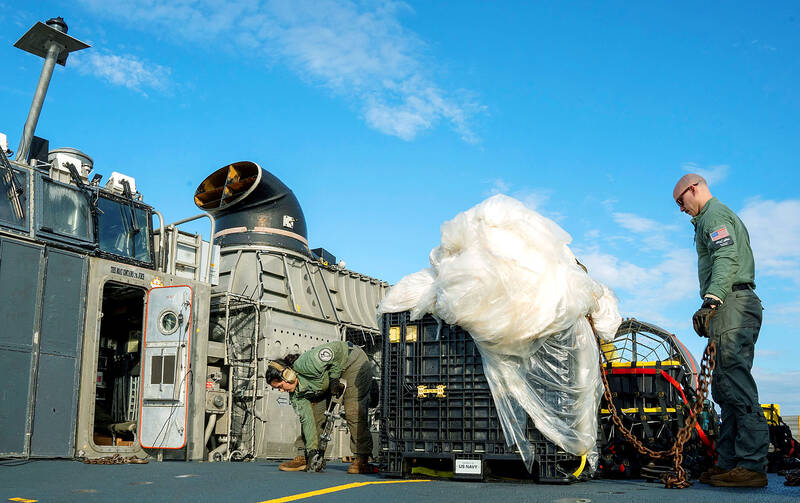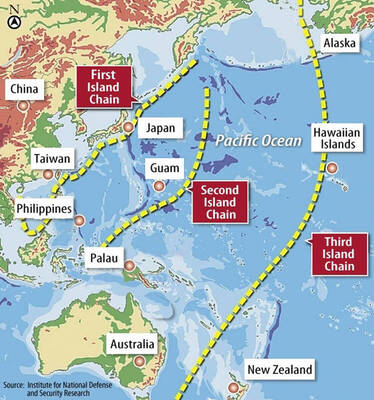All of the Chinese balloons that have been detected in Taiwan’s airspace were weather balloons and did not pose a security threat that justified shooting them down, the military said yesterday.
The Financial Times on Monday reported that dozens of Chinese military balloons have been spotted flying in Taiwanese airspace in the past few years.
“They come very frequently, the last one just a few weeks ago,” an unnamed senior Taiwanese official was quoted as saying.

Photo: Reuters
Similar incursions happen once a month on average, another unnamed official was cited as saying by the Financial Times.
Major General Huang Wen-chi (黃文?), who is with the Office of Deputy Chief of the General Staff on Intelligence, told a news conference yesterday that the Ministry of National Defense had no comment on the report.
The military would not make public the exact number of such incursions detected “to avoid giving away the sources of our intelligence gathering,” Huang said.
The number of detected balloons from China “are in accordance with the number of weather balloons it sends each year,” he said, implying that all of the balloons were likely for meteorological purposes.
Asked if the military had shot down any Chinese balloons, Huang said that the military has so far not found any of them to pose a serious threat to the degree that they needed to be destroyed.
However, the military would take such action if it found that a balloon was a major threat to Taiwan’s security, he added.
Previously, the ministry had only confirmed one instance of a flyover by Chinese balloons, when four batches flew over northern Taiwan in February last year.
Chinese balloon programs have drawn global attention after a suspected Chinese spy balloon was spotted in US airspace and shot down by the US on Feb. 4.
Taiwan has been circumspect about previous sightings of Chinese balloons.
On Feb. 27 last year, it said that prior to that day, there had been four sightings of balloons over Keelung, Taoyuan, Hsinchu and Taichung, and that they were likely for meteorological or scientific research purposes.
Meanwhile, China yesterday said that high-altitude balloons released by the US since May last year had entered its airspace.
Chinese Ministry of Foreign Affairs spokesman Wang Wenbin (汪文斌) said that US balloons “flew around the world and illegally entered the airspaces of China and other relevant countries at least 10 times.”
“The United States should conduct a thorough investigation and give China an explanation,” he said.
The US denied the allegation.
Separately, the US military on Monday said it had recovered electronics from the suspected Chinese spy balloon downed by a US fighter jet off South Carolina’s coast, including key sensors presumably used for intelligence gathering.
“Crews have been able to recover significant debris from the site, including all of the priority sensor and electronics pieces identified, as well as large sections of the structure,” the US military’s Northern Command said in a statement.
The balloon led to the US military to scour the skies for other objects that were not being captured by radar, leading to an unprecedented three shootdowns from Friday to Sunday.
US Secretary of Defense Lloyd Austin on Monday downplayed the risks posed by the objects.
“I want to reassure Americans that these objects do not present a military threat to anyone on the ground,” Austin said, speaking to reporters as he landed in Brussels for a NATO gathering. “They do, however, present a risk to civil aviation and potentially an intelligence collection threat.”
US officials have declined to connect the incidents, but Canadian Prime Minister Justin Trudeau on Monday said without elaborating that the four aerial objects shot down were somehow connected.

The US government has signed defense cooperation agreements with Japan and the Philippines to boost the deterrence capabilities of countries in the first island chain, a report by the National Security Bureau (NSB) showed. The main countries on the first island chain include the two nations and Taiwan. The bureau is to present the report at a meeting of the legislature’s Foreign Affairs and National Defense Committee tomorrow. The US military has deployed Typhon missile systems to Japan’s Yamaguchi Prefecture and Zambales province in the Philippines during their joint military exercises. It has also installed NMESIS anti-ship systems in Japan’s Okinawa

‘WIN-WIN’: The Philippines, and central and eastern European countries are important potential drone cooperation partners, Minister of Foreign Affairs Lin Chia-lung said Minister of Foreign Affairs Lin Chia-lung (林佳龍) in an interview published yesterday confirmed that there are joint ventures between Taiwan and Poland in the drone industry. Lin made the remark in an exclusive interview with the Chinese-language Liberty Times (the Taipei Times’ sister paper). The government-backed Taiwan Excellence Drone International Business Opportunities Alliance and the Polish Chamber of Unmanned Systems on Wednesday last week signed a memorandum of understanding in Poland to develop a “non-China” supply chain for drones and work together on key technologies. Asked if Taiwan prioritized Poland among central and eastern European countries in drone collaboration, Lin

BACK TO WORK? Prosecutors said they are considering filing an appeal, while the Hsinchu City Government said it has applied for Ann Kao’s reinstatement as mayor The High Court yesterday found suspended Hsinchu mayor Ann Kao (高虹安) not guilty of embezzling assistant fees, reducing her sentence to six months in prison commutable to a fine from seven years and four months. The verdict acquitted Kao of the corruption charge, but found her guilty of causing a public official to commit document forgery. The High Prosecutors’ Office said it is reviewing the ruling and considering whether to file an appeal. The Taipei District Court in July last year sentenced Kao to seven years and four months in prison, along with a four-year deprivation of civil rights, for contravening the Anti-Corruption

NO CONFIDENCE MOTION? The premier said that being toppled by the legislature for defending the Constitution would be a democratic badge of honor for him Premier Cho Jung-tai (卓榮泰) yesterday announced that the Cabinet would not countersign the amendments to the local revenue-sharing law passed by the Legislative Yuan last month. Cho said the decision not to countersign the amendments to the Act Governing the Allocation of Government Revenues and Expenditures (財政收支劃分法) was made in accordance with the Constitution. “The decision aims to safeguard our Constitution,” he said. The Constitution stipulates the president shall, in accordance with law, promulgate laws and issue mandates with the countersignature of the head of the Executive Yuan, or with the countersignatures of both the head of the Executive Yuan and ministers or